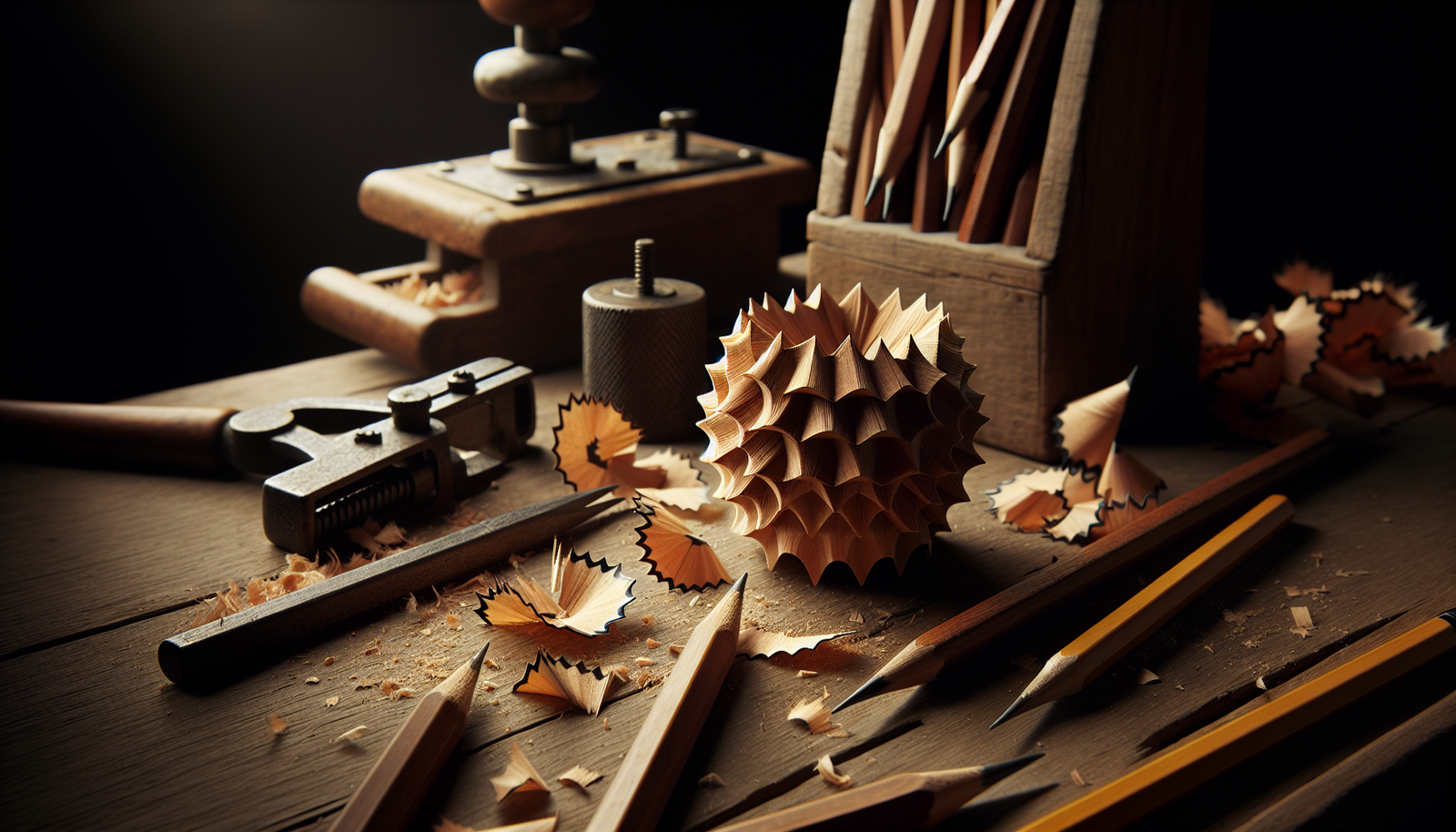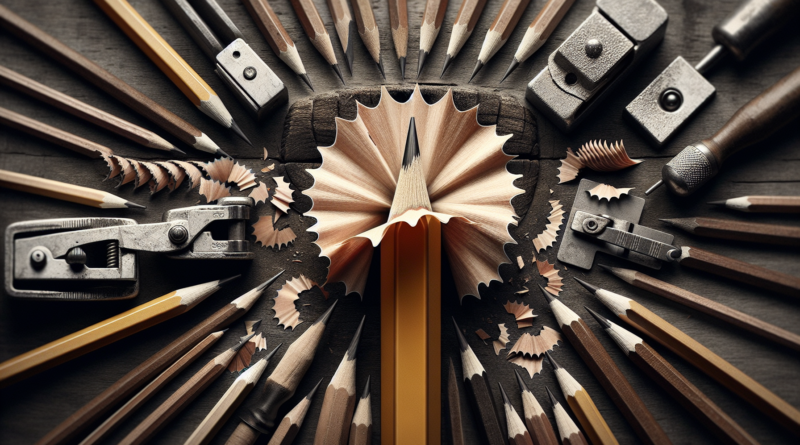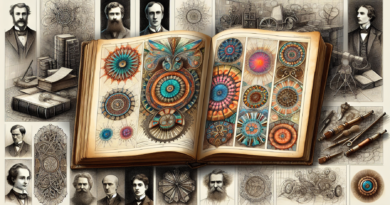Artisanal Pencil Sharpening
If you thought you had heard it all when it comes to niche crafts and specialized services, think again. Welcome to the world of artisanal pencil sharpening, a delightful and unexpected mix of precision, creativity, and craftsmanship. With a focus on the age-old task of sharpening pencils, artisans in this unique field take simplicity to a whole new level. Forget about mechanical pencil sharpeners or electric gadgets – these experts rely on manual sharpening techniques and an eye for detail to craft perfectly sharp pencils that are a joy to write or draw with. In a world that often values speed and efficiency, artisanal pencil sharpening offers a refreshing reminder of the beauty and artistry that can be found in the simplest of tasks. So, let’s take a closer look at this fascinating craft and discover why it has garnered such a devoted following.
Artisanal Pencil Sharpening
Welcome to the world of artisanal pencil sharpening! In this article, we will explore the fascinating history, the meticulous art, and the essential tools and techniques required for achieving the perfect point on your pencils. So, grab your favorite writing instrument and get ready to dive into the captivating world of artisanal pencil sharpening.

History of Pencil Sharpening
The history of pencil sharpening dates back to the 17th century when the first graphite pencils were invented. Initially, pencil sharpeners were simple blades that were used to shave off the wood casing and expose the graphite core. However, as the demand for sharpened pencils grew, the need for more efficient and precise sharpening methods arose. This led to the development of various sharpening techniques and tools over the years, eventually paving the way for the art of hand sharpening.
The Art of Hand Sharpening
Hand sharpening is the epitome of artisanal pencil sharpening. It involves the delicate process of carefully molding and shaping the tip of the pencil to achieve the desired level of sharpness and precision. The art lies not only in the physical act of sharpening but also in the attention to detail and the pursuit of perfection. Each stroke of the blade is guided by skill and experience, resulting in a beautifully sharpened pencil that glides smoothly across the paper.
Materials and Tools Required
To embark on your journey of artisanal pencil sharpening, you will need a few essential materials and tools. These include a high-quality pencil sharpener, preferably handheld or manual, as it offers more control and precision. You will also need a collection of different pencils with varying grades, a soft cloth for cleaning, and a dedicated workspace with good lighting. Additionally, having a pencil extender can come in handy when the pencil becomes too short to hold comfortably.
Choosing the Right Pencil Sharpener
When it comes to selecting a pencil sharpener for artisanal sharpening, there are a few factors to consider. Firstly, the sharpener should be made of high-quality materials to ensure durability and longevity. Look for sharpeners with strong blades that can maintain their sharpness over time. Secondly, the sharpener should have an adjustable mechanism to accommodate different pencil thicknesses. This allows for versatility in sharpening various types of pencils. Lastly, consider the design and ergonomics of the sharpener to ensure a comfortable and efficient sharpening experience.

Types of Pencil Sharpeners
There are several types of pencil sharpeners available, each offering its unique benefits and characteristics. The most common ones include the handheld sharpener, blade sharpener, and electric sharpener. Handheld sharpeners are known for their portability and simplicity, making them a popular choice among artists and writers. Blade sharpeners, on the other hand, have a more traditional charm and allow for precise control. Electric sharpeners offer a convenient and quick sharpening experience, ideal for those who require frequent sharpening.
Sharpening Techniques
Mastering the different sharpening techniques is crucial for achieving the perfect point on your pencils. The two main techniques are the rotating and stationary techniques. The rotating technique involves holding the sharpener steady while rotating the pencil in a clockwise motion. This provides a consistent and even sharpening. The stationary technique, on the other hand, requires moving the sharpener around the stationary pencil. This technique is especially useful for maintaining the original shape of the pencil tip.
Sharpening for Different Pencil Grades
Different pencil grades require different sharpening techniques to achieve optimal results. For softer graphite pencils, such as B or 2B, a slightly blunter point is desired to prevent breakage and allow for smooth shading. On the other hand, harder graphite pencils, such as H or 2H, require a sharper point for precise lines and detailed drawings. Adjust your sharpening technique accordingly to accommodate the specific needs of each pencil grade.
Tips for Achieving the Perfect Point
To achieve the perfect point on your pencils, here are a few tips to keep in mind. Firstly, make sure to clean the blade of your sharpener regularly to prevent any buildup of graphite residue. This will ensure a clean and precise sharpening every time. Secondly, hold the pencil gently but securely as you sharpen it, allowing the blade to do its job without applying excessive force. Finally, always test the sharpness of the pencil on a scrap piece of paper before using it for your artwork or writing to ensure it meets your desired level of sharpness.
Common Mistakes to Avoid
In the pursuit of artisanal pencil sharpening, it is crucial to avoid common mistakes that can hinder the quality of your sharpened pencils. One common mistake is over-sharpening, which can lead to fragile tips that break easily. Avoid applying too much pressure or sharpening the pencil too aggressively. Another mistake to watch out for is neglecting to clean the blade of your sharpener regularly. The buildup of graphite residue can affect the quality of the sharpening and result in a less precise point. Remember to clean your sharpener after every use.
Taking Care of Sharpened Pencils
Once you have achieved the perfect point on your pencils, it is important to take proper care of them to maintain their sharpness and functionality. Avoid dropping or mishandling the sharpened pencils, as this can lead to breakage or chipping of the delicate tips. Store your sharpened pencils in a dedicated pencil case or holder to protect them from damage. Additionally, consider investing in a pencil cap or a pencil extender to safeguard the tip when not in use or when it becomes too short to hold comfortably.
Artisanal pencil sharpening is not just about making a pencil sharp; it is about the craftsmanship, attention to detail, and appreciation for the writing and drawing experience. So, the next time you pick up a pencil, take a moment to savor the beauty of a well-sharpened point, knowing that it was achieved with care, skill, and a touch of artistry. Happy sharpening!


